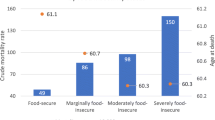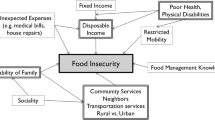Abstract
Using data from the fifth wave of the Survey of Health, Ageing and Retirement in Europe, this study investigates the association between food insecurity (FI) and several demographic and socioeconomic characteristics in a sample of individuals aged 50 and over in 15 European countries. On average, approximately 12% of individuals that eat meat/fish/poultry or fruit/vegetables less than 3 times per week cannot afford to eat these food items more often. Our Heckman probit analysis reveals that being employed, having higher levels of education and household income are associated with a lower probability of being unable to afford meat/fish/poultry or fruit/vegetables on a regular basis. Pronounced country-specific heterogeneity is also observed in food unaffordability: relative to Germany, the Eastern and Southern European countries, particularly the Czech Republic, Estonia, France, Italy, and Spain, are more vulnerable to food unaffordability. Nonlinear decompositional results show that household income and being employed are the two main contributors to the food unaffordability gap between high FI and low FI prevalence among European countries.

Similar content being viewed by others
Notes
The results with the replication of 5000 are quite similar to those in Table 5 and are available from the authors upon request.
As any demarcation is quite arbitrary, we conducted a robustness test in which we also developed groups based on the five highest and five lowest ranking countries for meat/fish/poultry and fruit/vegetables. The results are qualitatively similar.
References
AGE Platform Europe. (2012). Older people also suffer because of the crisis. Brussels: AGE Platform Europe.
Alaimo, K., Briefel, R. R., Frongillo Jr., E. A., & Olson, C. M. (1998). Food insufficiency exists in the United States: results from the third National Health and nutrition examination survey (NHANES III). American Journal of Public Health, 88(3), 419–426.
Alavinia, S. M., & Burdorf, A. (2008). Unemployment and retirement and ill-health: a cross-sectional analysis across European countries. International Archives of Occupational and Environmental Health, 82(1), 39–45.
Anderson, S. A. (1990). Core indicators of nutritional state for difficult-to-sample populations. Journal of Nutrition, 120(11S), 1559–1600.
Álvares, L., & Amaral, T. F. (2014). Food insecurity and associated factors in the Portuguese population. Food and Nutrition Bulletin, 35(4), S395–S402.
Bocquier, A., Vieux, F., Lioret, S., Dubuisson, C., Caillavet, F., & Darmon, N. (2015). Socio-economic characteristics, living conditions and diet quality are associated with food insecurity in France. Public Health Nutrition, 18(16), 2952–2961.
Borjas, G. J. (2004). Food insecurity and public assistance. Journal of Public Economics, 88(7–8), 1421–1443.
Börsch-Supan, A., & Jürges, H. (2005). The survey of health, ageing and retirement in Europe – methodology. Mannheim: MEA, Max Planck Institute for Social Law and Social Policy.
Börsch-Supan, A., Brandt, M., Hunkler, C., Kneip, T., Korbmacher, J., Malter, F., et al. (2013). Data resource profile: the survey of health, ageing and retirement in Europe (SHARE). International Journal of Epidemiology, 42(4), 992–1001.
Che, J., & Chen, J. J. (2001). Food insecurity in Canadian households. Health Reports, 12(4), 11–21.
Elanco. (2015). Dimensions of food security in Europe. Basel: Elanco.
Elia, M., & Stratton, R. J. (2005). Geographical inequalities in nutrient status and risk of malnutrition among English people aged 65 y and older. Nutrition, 21(11–12), 1100–1106.
European Commission Directorate-General for Agriculture and Rural Development. (2012). Europeans’ attitudes towards food security, food quality and the countryside. Brussels: European Commission, Directorate-General for Agriculture and Rural Development.
Fairlie, R. W. (1999). The absence of the African-American owned business: an analysis of the dynamics of self-employment. Journal of Labor Economics, 17(1), 80–108.
Fairlie, R. W. (2016). Addressing path dependence and incorporating sample weights in the nonlinear blinder-Oaxaca technique for logit, probit and other nonlinear models. Santa Cruz: University of California, Santa Cruz.
FAO, IFAD and WFP. (2015). The State of Food Insecurity in the World 2015. Meeting the 2015 international hunger targets: taking stock of uneven progress. Rome: FAO.
Gunderson, C., & Oliveira, V. (2001). The food stamp program and food insufficiency. American Journal of Agricultural Economics, 83(4), 875–887.
Gunderson, C., Kreider, B., & Pepper, J. (2011). The economics of food insecurity in the united state. Applied Economic Perspectives and Policy, 33(3), 281–303.
Harper, S. (2014). Economic and social implications of aging societies. Science, 346(6209), 587–591.
Katsikas, D., Karakitsios, A., Filinis, K., & Petralias, A. (2014). Social profile report on poverty social exclusion and inequality before and after the crisis in Greece. Athens: Greek General Secretariat for Research and Technology.
Laraia, B. A., Maria Siega-Riz, A., Gundersen, C., & Dole, N. (2006). Psychological factors and socioeconomic indicators are associated with household food insecurity among pregnant women. Journal of Nutrition, 136(1), 177–182.
Lee, J. S., & Frongillo Jr., E. A. (2001). Factors associated with food insecurity among U.S. elderly persons: importance of functional impairments. The Journals of Gerontology Series B: Psychological Sciences and Social Sciences, 56(2), S94–S99.
Loopstra, R., Reeves, A., & Stuckler, D. (2015). Rising food insecurity in Europe. The Lancet, 385(9982), 2041.
Loopstra, R., Reeves, A., Mckee, M., & Stuckler, D. (2016). Food insecurity and social protection in Europe: quasi-natural experiment of Europe's great recessions 2004–2012. Preventive Medicine, 89, 44–50.
Malter, F., & Börsch-Supan, A. (2015). SHARE wave 5: Innovations & Methodology. Munich: MEA, Max Planck Institute for Social Law and Social Policy.
Pfeiffer, S., Ritter, T., & Hirseland, A. (2011). Hunger and nutritional poverty in Germany: quantitative and qualitative empirical insights. Critical Public Health, 21(4), 417–428.
Pfeiffer, S., Ritter, T., & Oestreicher, E. (2015). Food insecurity in German households: qualitative and quantitative data on coping, poverty consumerism and alimentary participation. Social Policy and Society, 14(3), 483–495.
Quandt, S., & Rao, P. (1999). Hunger and food security among older adults in a rural community. Human Organization, 58(1), 28–35.
Ready for Ageing Alliance. (2015). The myth of the baby boomer: ready for ageing alliance. London: Ready for Ageing Alliance.
Schwiebert, J. (2015). A detailed decomposition for nonlinear econometric models. The Journal of Economic Inequality, 13(1), 53–67.
Tingay, R. S., Tan, C. J., Tan, N. C. W., Tang, S., Teoh, P. F., Wong, R., et al. (2003). Food insecurity and low income in an English inner city. Journal of Public Health, 25(2), 156–159.
Wolfe, W. S., Olson, C. M., Kendall, A., & Frongillo, E. A. (1998). Hunger and food insecurity in the elderly: its nature and measurement. Journal of Aging and Health, 10(3), 327–350.
Acknowledgements
This paper uses data from SHARE Wave 5 (DOI:10.6103/SHARE.w5.100; see Börsch-Supan et al. 2013, for methodological details). The SHARE data collection was primarily funded by the European Commission through the FP5 (QLK6-CT-2001-00360), FP6 (SHARE-I3: RII-CT-2006-062193, COMPARE: CIT5-CT-2005-028857, SHARELIFE: CIT4-CT-2006-028812) and FP7 (SHARE-PREP: N°211909, SHARE-LEAP: N°227822, SHARE M4: N°261982). Additional funding from the German Ministry of Education and Research, the U.S. National Institute on Aging (U01_AG09740-13S2, P01_AG005842, P01_AG08291, P30_AG12815, R21_AG025169, Y1-AG-4553-01, IAG_BSR06-11, OGHA_04-064) and from various national funding sources is gratefully acknowledged (see www.share-project.org). We would like to thank those who provided the data needed for this paper, although the findings, interpretations, and conclusions are entirely our own. We would also like to thank two anonymous referees for valuable comments on an earlier version of this paper.
Author information
Authors and Affiliations
Corresponding author
Ethics declarations
Conflict of Interest
The authors declare no conflicts of interest.
Appendix
Appendix
Rights and permissions
About this article
Cite this article
Nie, P., Sousa-Poza, A. Food Insecurity among Europeans Aged 50+. Population Ageing 11, 133–151 (2018). https://doi.org/10.1007/s12062-017-9177-3
Received:
Accepted:
Published:
Issue Date:
DOI: https://doi.org/10.1007/s12062-017-9177-3




